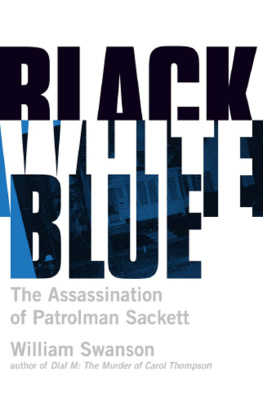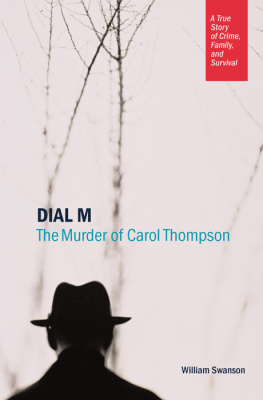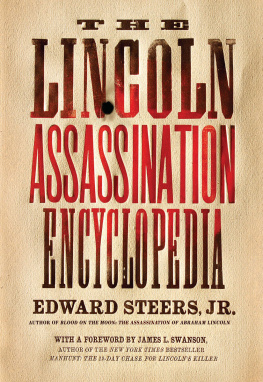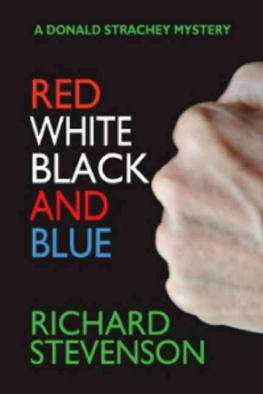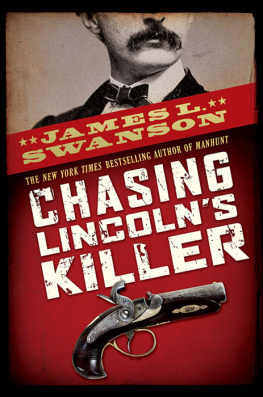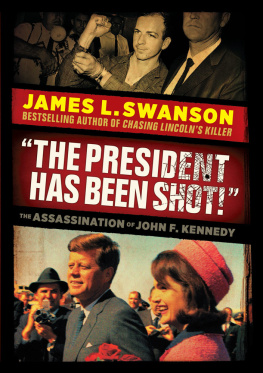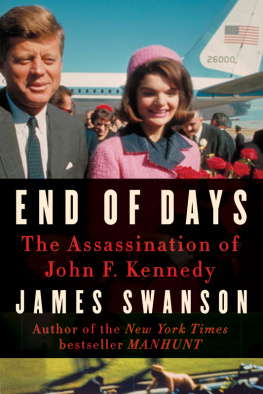William Swanson - Black White Blue: The Assassination of Patrolman James Sackett
Here you can read online William Swanson - Black White Blue: The Assassination of Patrolman James Sackett full text of the book (entire story) in english for free. Download pdf and epub, get meaning, cover and reviews about this ebook. year: 2012, publisher: Borealis Books, genre: Non-fiction / History. Description of the work, (preface) as well as reviews are available. Best literature library LitArk.com created for fans of good reading and offers a wide selection of genres:
Romance novel
Science fiction
Adventure
Detective
Science
History
Home and family
Prose
Art
Politics
Computer
Non-fiction
Religion
Business
Children
Humor
Choose a favorite category and find really read worthwhile books. Enjoy immersion in the world of imagination, feel the emotions of the characters or learn something new for yourself, make an fascinating discovery.
- Book:Black White Blue: The Assassination of Patrolman James Sackett
- Author:
- Publisher:Borealis Books
- Genre:
- Year:2012
- Rating:3 / 5
- Favourites:Add to favourites
- Your mark:
- 60
- 1
- 2
- 3
- 4
- 5
Black White Blue: The Assassination of Patrolman James Sackett: summary, description and annotation
We offer to read an annotation, description, summary or preface (depends on what the author of the book "Black White Blue: The Assassination of Patrolman James Sackett" wrote himself). If you haven't found the necessary information about the book — write in the comments, we will try to find it.
Black White Blue: The Assassination of Patrolman James Sackett — read online for free the complete book (whole text) full work
Below is the text of the book, divided by pages. System saving the place of the last page read, allows you to conveniently read the book "Black White Blue: The Assassination of Patrolman James Sackett" online for free, without having to search again every time where you left off. Put a bookmark, and you can go to the page where you finished reading at any time.
Font size:
Interval:
Bookmark:
Black White Blue
Black White Blue
Black White Blue
The Assassination
of Patrolman Sackett
WILLIAM SWANSON

Borealis Books is an imprint of the Minnesota Historical Society Press.
www.mhspress.org
2012 by William Swanson. All rights reserved. No part of this book may be used or reproduced in any manner whatsoever without written permission, except in the case of brief quotations embodied in critical articles and reviews. For information, write to Borealis Books, 345 Kellogg Blvd. W., St. Paul, MN 55102-1906.
The Minnesota Historical Society Press is a member of the Association of American University Presses.
Manufactured in the United States of America
10 9 8 7 6 5 4 3 2 1
 The paper used in this publication meets the minimum requirements of the American National Standard for Information SciencesPermanence for Printed Library Materials, ANSI Z39.48-1984.
The paper used in this publication meets the minimum requirements of the American National Standard for Information SciencesPermanence for Printed Library Materials, ANSI Z39.48-1984.
International Standard Book Number
ISBN: 978-0-87351-870-3 (cloth)
ISBN: 978-0-87351-871-0 (e-book)
Library of Congress Cataloging-in-Publication Data
Swanson, William, 1945
Black, white, blue: the assassination of patrolman Sackett / William Swanson.
p. cm.
ISBN 978-0-87351-870-3 (cloth: alk. paper) ISBN 978-0-87351-871-0 (e-book)
1. Sackett, James. 2. Murder victimsMinnesotaSaint PaulCase studies.
3. MurderMinnesotaSaint PaulCase studies. I. Title.
HV6533.M6S93 2012
364.1523092dc23
2012018637
For my family
and the boys move against the traffic as though they are moving against the enemy. The enemy is not there, of course, but his soldiers are, in patrol cars, armed.
J AMES B ALDWIN
There had always been rules in the game. One had to have a good reason to kill a cop.
J OSEPH W AMBAUGH
Part One
Young Men and Murder
Police. Kinderman.
Yes. I was wondering if you could send a squad car down to 859 Hague.
Whats the trouble?
Uh, my sisters getting ready to have a baby, and we have no transportation.
Okay, just a moment. Eight-six-nine?
Eight-fifty-nine.
Eight-five-nine.
Hague.
Eight-five-nineis that correct?
Yes.
Hague. What apartment number?
Its on the first floor.
Okay. How close is the baby due?
Well, shes having pains two minutes apart.
Okay. What is the last name, please?
Brown. B-R-O-W-N.
Phone number, please.
Im at the phone booth now.
Okay, 859 Hague. First floor.
Yes.
Thank you. Bye.
T he young womans voice was soft and unhurried, with a trace of a languid drawl. She did not ask for, much less demand, a squad carshe wondered if a car could be dispatched. She might have been ordering a pizza or, if it wasnt already a few minutes after midnight, a blouse or a pair of shoes she had seen in a Daytons department store ad in the paper. On the other end of the line, the flat, midwestern male voice bore the patient air of a desk-bound cop who answers hundreds of such calls in a career and knows from experience that the situation at 859 Hague, first floor, will more likely than not be all in a nights work for the officers directed its way.
In 1970, more than a decade before the adoption of the 911 emergency call system, a citizen needing help or having some other urgent reason to call the police in St. Paul, Minnesota, dialed 224-7391. (Callers using a pay phone got their dime back.) In addition to their law-enforcement responsibilities, the police provided crisis medical service in the capital city, responding in Chevrolet station wagons called stretcher cars or more fully equipped International Harvester emergency trucks to everything from auto accidents and domestic violence to heart attacks and premature babies.
On most nights there was either a stretcher car or an emergency truck available in the area, but because of the midnight shift change none was in the vicinity when John Kinderman took the call regarding Mrs. Brown at 12:04 on May 22. The nearest patrol car was Squad 337, but patrolmen Edward Steenberg and John LaBossiere were investigating a theft from a car at Grand Avenue and Oxford Street, eight blocks away, so the dispatcher queried Squad 327 for its location. Despite the responseRight in front of the Capitol327 was told, at approximately seven minutes after midnight, to proceed to 859 Hague to take care of an O.B. When patrolman Glen Kothe pointed out that 327 was a traffic car, not an emergency vehicle, the dispatcher replied, Three-twenty-seven, youre the only one I have available right now. With no further discussion, Kothe confirmed, and 327 proceeded toward the Hague Avenue address, about two miles away.
St. Paul was a middling city, with a population, according to the 1970 census, of 309,980, and comprised fifty-six square miles in a rough horizontal rectangle abutting the Mississippi River and the city of Minneapolis, its larger, flashier twin. In the wee hours of a Friday morning, with scant traffic and benign weather conditions (for the moment), it would take a squad car little more than five minutes to travel from the Capitol, just north of downtown, to Hague Avenue at Victoria Street.
Squad 327 was not representative of St. Pauls familiar dark-blue-and-white police department fleet. It was a factory-new Plymouth 440a rakish two-door, burnt-orange muscle caron the street that night for the first time. Its unusual color and the fact that its only exterior marking was a police shield the size of a dinner plate on the passenger-side door would presumably make it a stealthily effective traffic car. But manned by Kothe and another young patrolman, James Sackett, Squad 327 had made only a couple of routine traffic stops since coming on duty as part of the 8 PM power shift. Free to roam, the partnersa couple of frisky gearheads enjoying the improbable car they were driving that nightcruised the downtown Loop, took a swing through the East Side, and, in Kothes words, ran in on a call or two and stuff like that. Sitting in the shadow of Cass Gilberts monumental Capitol for maybe three-quarters of an hour, they had little to do. Later, Kothe reckoned they made only a single stop at the site that night.
St. Paul was hardly a wild town, though by 1970 it had begun to feel the tensions that had been tearing at the fabric of larger, more fractious communities for the past several years. It was a time of conflict and change. The escalating war in Vietnam was unpopular across the United States, and antiwar demonstrations had turned increasingly violent. Activists among African Americans, Native Americans, and Latinos had become strident in their demands for equality and respect and were joining radicalized womens and youth groups in the streets of the nations cities and campuses. Street crime, from purse-snatchings to murder, had risen almost everywhere during the 1960s, including in St. Paul. When, during the long, hot summer of 1967, African Americans torched storefronts and skirmished with police on the North Side of Minneapolis, St. Paul remained calm. There was little concentrated violence in either city, for that matter, when other cities burned following Martin Luther King Jr.s assassination in April 1968. During the Labor Day weekend that year, however, St. Paul was shaken out of whatever complacency it might have enjoyed when a dance at Stem Hall, a dingy downtown arena, got out of handpredictably, there were conflicting accounts of what sparked the disturbanceand young blacks fought a running battle with the police between downtown and the Selby-Dale section of the nearby Summit-University neighborhood.
Next pageFont size:
Interval:
Bookmark:
Similar books «Black White Blue: The Assassination of Patrolman James Sackett»
Look at similar books to Black White Blue: The Assassination of Patrolman James Sackett. We have selected literature similar in name and meaning in the hope of providing readers with more options to find new, interesting, not yet read works.
Discussion, reviews of the book Black White Blue: The Assassination of Patrolman James Sackett and just readers' own opinions. Leave your comments, write what you think about the work, its meaning or the main characters. Specify what exactly you liked and what you didn't like, and why you think so.

